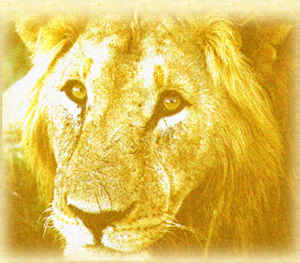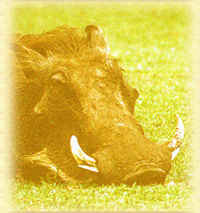|
| ||||||
|
|
|
|
|
|
|
|
Monday, December 20, 1999: Kichwa Tembo - Masai Mara  Charles drove us to Wilson Airport, the domestic terminal in Nairobi for our 10 a.m. AirKenya puddle jumper to the Masai Mara. The airport looked a bit like the bus station. We checked in, got a laminated boarding card, and they'd walk right in off the tarmac, call our flight and out we'd go to the plane.
Charles drove us to Wilson Airport, the domestic terminal in Nairobi for our 10 a.m. AirKenya puddle jumper to the Masai Mara. The airport looked a bit like the bus station. We checked in, got a laminated boarding card, and they'd walk right in off the tarmac, call our flight and out we'd go to the plane.
The plane was a Dash-8, little more than a box with 20 seats and a couple of engines. We found out our flight was actually three stops. AirKenya stops at small dirt strips in the Mara to drop off passengers. Ours was the first stop: a half-mile long dirt strip with a thatched roof hut and a windsock. Oddly, it was the nicest airport we'd go to over the next few days. Masai Mara covers about 700 square miles, and was a bit of a backwater until Kenya closed its border with Tanzania in the 1960s. The area then gained popularity, becoming the most popular safari spot in Kenya. The park is part of the Serengeti, forming one continuous ecosystem spanning the border. It is also the only place in Kenya that permits offroad safaris, which let you get within feet of animals in their natural habitat, who are more than used to tourists at this point.
We got to the camp around noon, and our game drive in an open air Land Rover wasn't until 3:30, so we had a buffet lunch (excellent, European style food) and hung around the grounds, enjoying the view and watching a herd of antelopes just on the other side of the fence. The camp also has a few monkeys living on the grounds, as well as some mongooses and a family of warthogs, who could be seen kneeling and eating grass along the main grounds. As evidence that western culture does permeate, t-shirts emblazoned with "Hakuna Matata" could be found in the gift shop. We sat in on a Masai lecture, given by a Masai warrior named Joseph. There we learned that I, as a non-Masai, was worth nothing and could be killed and it would be okay in Masai culture as I wasn't a tribesman. Jen, as a non-Masai, but a woman, was worth 48 cows exactly. I calculated the price of beef and decided against a trade. The Masai culture revolves around cattle herding. Their abodes are made of cow dung and straw, and the individual tribes tend to move every few years. Polygamy is also accepted, and a man's worth is measured not just by the number of cows he owns, but the number of wives he has. Africa was definitely growing on me...
What did we see? What didn't we. A rhino, water buffalo, topes, zebras, giraffes, elephants, lions, antelope, gazelles, birds, all in such abundance that it became almost commonplace after a couple of hours. And this wasn't at a distance. In all cases, we were within feet of the animals who usually were either eating or napping when we came by. The animals, it appeared, were very used to the appearance of tourists and, after establishing they were in no danger, proceeded to ignore us. It was wonderful.
That evening, after dinner, there was a Masai dance at the camp, where a group of about 20 Masai warriors came in for about 20 minutes. Jen was invited to dance with them along with other tourists and did so wonderfully, though she didn't take part in the buffalo dance, which involves vertical jumping that would put an NBA forward to shame. Afterwards, as we discovered, it was also tradition to try to sell stuff to the tourists. By now, we had learned negotiation was key. Jen picked up a hand-beaded purse for US$18, talked down from US$40. It easily would sell for 10 times that in the States. Famous quote of the evening to Jen from a Masai warrior: "So, mama wants to negotiate?"
|  |
 |
 |
 |
 |
 |
 |
 |
 | ||||||
 |
 |
 |
 |
 |
 |
 |
 |
 |
 | ||||||
 |
 |
 |
 |
 |
 |
 |
 |
 |
 | ||||||
 |
 |
 |
|||||||||||||
![]()
|
© Copyright 2024 Canty and Associates LLC Webmaster |
 We were staying at
We were staying at  The game drive started at 3:30, and it was pretty damn bumpy, and like nothing I've ever experienced. Jen and I were giddy on the sites, the smells, and above all, the views that stretched across the plain from horizon to horizon, marred only by the odd windblown tree or the abundant, tall termite mounds that seemed to always be just missing the tires of our jeep.
The game drive started at 3:30, and it was pretty damn bumpy, and like nothing I've ever experienced. Jen and I were giddy on the sites, the smells, and above all, the views that stretched across the plain from horizon to horizon, marred only by the odd windblown tree or the abundant, tall termite mounds that seemed to always be just missing the tires of our jeep.